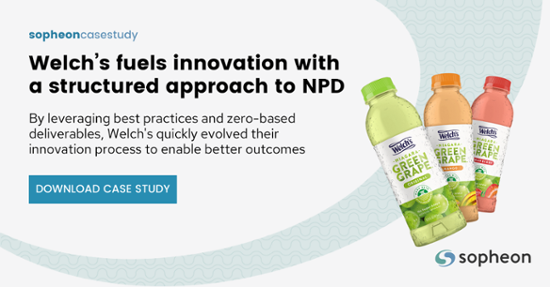Reading time: 4 minutes
Agile and gated methodologies play critical roles in the NPD process. What’s more, innovation leaders don’t have to choose. They can take the best parts of a gated process and combine them with the iterative development nature of Agile.
Is Agile killing gated processes? This question is on the minds of many business leaders as companies seek more efficient, effective new product development processes to stay ahead of the competition and get products to market, faster. While a phase gate approach seems to be in direct conflict with the principles of Agile, you’ll find that both approaches are valuable and can work side-by-side. In fact, there are significant disadvantages in today’s highly competitive NPD environment in taking a single approach to innovation processes.
Phase gate: Good governance
A tried-and-true NPD methodology, phase gate is a risk management process; this method maps out a project into distinct phases, with each new phase beginning when the previous one has been completed. Funding and resources are released for one phase at a time. This enables companies to reserve and reallocate funding and resources to alternative initiatives that might lead to a better outcome.
A phase gate approach reduces risk when introducing new products to market. It is a valuable process for identifying products that are less likely to succeed and identifying it earlier in the new product development journey. This gives the organization time to react and divert the funds to a more valuable project.
Gated processes also afford an alignment with market needs and corporate strategies because market-readiness and strategic fit are evaluated early and often. It standardizes ways of working and creates “guardrails” for programs, helping to replicate success over time or find gaps when things go wrong.
However, a phased based approach can add a level of rigor that may seem counter-intuitive to people working in Agile environments. For example, a gated process may include deliverables and gate reviews that are perceived as unnecessary and, therefore, would make innovation teams slow to respond to changes in economic disruptions, product assumptions, revenue projections, or risk analysis.
For a more in-depth explanation of phase gate, listen to this episode of Innovation+Talks

Agile: Engineering flexibility
The Agile methodologies (scrum, kanban, etc.) are a favorite of software developers and technology engineers because they allow for changes in the product target and in the approach used to create the final product. It supports the idea of small pieces of work that can progressively move towards a potentially changing target. Its core concept of self-empowered teams provides a level of flexibility that a traditional phase gate process lacks.
In the phase gate process, the focus is on the overall market definition, product definition and product value; the actual engineering is generally not prescribed. The phase gate process often assumes a fixed product definition going into the development phase, and the methodology struggles to support a changing product target.
When a phase gate approach is extended as a means to try to control product engineering, the resulting rigidity works against the Agile methodology. Phase gate should not be used in this way, but too often is.
That said, an Agile approach can lead to a loss of coordination, especially when multiple engineering groups are involved.
Aside from the loss of interaction that arises when teams are running independent Agile processes, the combined outcome can be significantly off mark, especially if teams are thinking in terms of “minimal viable product” (MVP) or adjusting the product definition to meet deadlines or their own perceptions of market needs.
In other words, when the Agile methodology is used to develop new products, the resulting combined outcome can be far different than what was expected.
Agile methodologies can be used for more than product engineering. Additional areas where Agile approaches can provide value are:
- product validation,
- voice of customer, and
- test-and-learn type of work
The value of using Agile approaches for these areas should not be underestimated. Teams should seek to use Agile approaches to perform work within the appropriate stages.
Learn more about Agile in innovation with Kathy Iberle in this episode of Innovation+Talks.
Agility in phase gate
We see the need for establishing agility and flexibility within the phase gate process, empowering innovation teams to modify and adjust the process as they go along.
It is possible to provide a governance framework without prescribing in detail the exact details every innovation team must follow every time. It is even possible for an innovation system to make process suggestions to the innovation teams. By doing so, the phase gate process can become more effective and easier for teams to adopt.
The future of Gated Agile methodologies for NPD
By combining gated and Agile processes, along with making phase gate more flexible, organizations can overcome the limitations of any one process.
An Agile methodology emphasizes focus on “one thing at a time” so large, complex projects can be brought to fruition more effectively and efficiently. Adding an extra layer of governance through a gated process establishes guardrails, fosters coordination, and helps with launch preparations and decisions by providing the necessary structure. And making the gated process flexible leverages the knowledge of the innovation teams and improves time to market.
The upshot? Agile and gated methodologies play critical roles in the NPD process. What’s more, innovation leaders don’t have to choose. They can take the best parts of a gated process for cross-functional collaboration, templated deliverables and strong governance, and combine them with the holistic product development benefits of Agile.
To learn more about this hybrid approach to NPD, watch this webinar I hosted with Innov8rs
Watch the webinarRead this case study to get an insider view on how food company Welch’s finds the balance between rigid and flexible innovation processes to get products to market faster.







